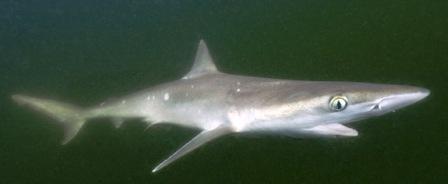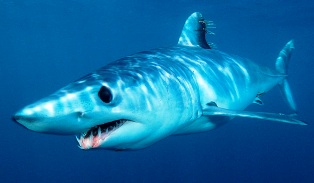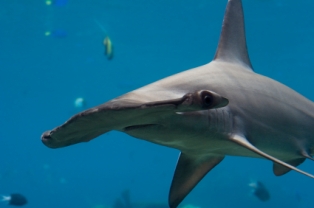Discover Florida Nature
It's time to explore the natural Florida


|
|
|
|
|
 Atlantic Sharpnose
Shark (Rhizoprionodon terraenovae) Atlantic sharpnose
sharks get their name from a characteristically long snout, which is
longer than the width of the mouth. English language common names are
Atlantic sharpnose shark, Newfoundland shark, sharp-nosed shark, and
white shark. The Atlantic sharpnose shark is a small shark that attains
a maximum size of 1.2 meters (4 feet). It has a long snout and labial
folds around its mouth. The triangular smooth edged teeth are similar on
both the upper and lower jaws. The Atlantic sharpnose shark can be
brown, olive-gray or blue-gray turning to white on the underside. Adults
may have some white spots and smaller individuals tend to have black
edged dorsal and caudal fins. This shark consumes shrimp, mollusks and
small fishes. This small shark is found in the coastal waters of South
Carolina, Florida and the Gulf of Mexico where it is a year round
resident. Atlantic Sharpnose
Shark (Rhizoprionodon terraenovae) Atlantic sharpnose
sharks get their name from a characteristically long snout, which is
longer than the width of the mouth. English language common names are
Atlantic sharpnose shark, Newfoundland shark, sharp-nosed shark, and
white shark. The Atlantic sharpnose shark is a small shark that attains
a maximum size of 1.2 meters (4 feet). It has a long snout and labial
folds around its mouth. The triangular smooth edged teeth are similar on
both the upper and lower jaws. The Atlantic sharpnose shark can be
brown, olive-gray or blue-gray turning to white on the underside. Adults
may have some white spots and smaller individuals tend to have black
edged dorsal and caudal fins. This shark consumes shrimp, mollusks and
small fishes. This small shark is found in the coastal waters of South
Carolina, Florida and the Gulf of Mexico where it is a year round
resident. Bonnethead
Shark
(Tetrapturuspfluegeri) The average Bonnethead
shark (also known as the Shovelhead shark) is a small, common hammerhead
shark with a smooth, rounded head.The Bonnethead shark is harmless to
people; it is a timid shark. It is a harmless, timid shark that is
gray-brown above and lighter on the underside with short pectoral fins.
The average Bonnethead shark averages about 3.3 feet long. The
Bonnethead shark has a varied diet. The average Bonnethead shark has
small, sharp teeth in the front of the mouth (for grabbing soft prey)
and flat, broad molars in the back (for crushing hard-shelled prey).
It eats both hard-shelled prey (like crustaceans and mollusks) and soft
prey (like small fish), and has a variety of teeth to eat all these
animals. Bonnetheads are found in the western Atlantic and eastern
Pacific Oceans, in the surf zone, reefs, on sandy bottoms and in
estuaries. Large schools of Bonnethead sharks migrate to warm water in
the winter and cooler water in the summer. Bonnethead
Shark
(Tetrapturuspfluegeri) The average Bonnethead
shark (also known as the Shovelhead shark) is a small, common hammerhead
shark with a smooth, rounded head.The Bonnethead shark is harmless to
people; it is a timid shark. It is a harmless, timid shark that is
gray-brown above and lighter on the underside with short pectoral fins.
The average Bonnethead shark averages about 3.3 feet long. The
Bonnethead shark has a varied diet. The average Bonnethead shark has
small, sharp teeth in the front of the mouth (for grabbing soft prey)
and flat, broad molars in the back (for crushing hard-shelled prey).
It eats both hard-shelled prey (like crustaceans and mollusks) and soft
prey (like small fish), and has a variety of teeth to eat all these
animals. Bonnetheads are found in the western Atlantic and eastern
Pacific Oceans, in the surf zone, reefs, on sandy bottoms and in
estuaries. Large schools of Bonnethead sharks migrate to warm water in
the winter and cooler water in the summer.  Shortfin Mako
(Isurus oxyrinchus) The shortfin mako shark is a sleek spindle
shaped shark with a long conical snout. This shark has short pectoral
fins and a crescent shaped caudal (tail) fin. There is a distinct caudal
keel on the caudal base. Its second dorsal fin is much smaller than the
first. The teeth are are slender and slightly curved with no lateral
cusps, and are visible even when the mouth is closed. There is marked
counter shading on this shark: dorsally it is a metallic indigo blue
while ventrally it is white. The shortfin mako can grow to lengths of
3.9 meters (13 feet). There is still some uncertainty about its
life-span, but it is suspected to reach ages of between 11-23 years. As
one of the fastest sharks in the ocean, this powerful shark can attain
burst swimming speeds of up to 22 mph and can leap clear of the water to
heights of up to 20 feet. These qualities have made this species a
sought after sport fish in some parts of its range.
The shortfin mako feeds mainly upon bony fishes including mackerels,
tunas, bonitos and swordfish, but may also eat other sharks, porpoises
and sea turtles. Shortfin mako sharks live in tropical and temperate
offshore waters. They are a pelagic species that occur from the surface
down to depths of 490 feet. This shark is seldom found in waters colder
than 16 degrees Celsius. The shortfin mako is found worldwide. In the
western Atlantic it can be found from Argentina and the Gulf of Mexico
to Browns Bank off of Nova Scotia. Shortfin Mako
(Isurus oxyrinchus) The shortfin mako shark is a sleek spindle
shaped shark with a long conical snout. This shark has short pectoral
fins and a crescent shaped caudal (tail) fin. There is a distinct caudal
keel on the caudal base. Its second dorsal fin is much smaller than the
first. The teeth are are slender and slightly curved with no lateral
cusps, and are visible even when the mouth is closed. There is marked
counter shading on this shark: dorsally it is a metallic indigo blue
while ventrally it is white. The shortfin mako can grow to lengths of
3.9 meters (13 feet). There is still some uncertainty about its
life-span, but it is suspected to reach ages of between 11-23 years. As
one of the fastest sharks in the ocean, this powerful shark can attain
burst swimming speeds of up to 22 mph and can leap clear of the water to
heights of up to 20 feet. These qualities have made this species a
sought after sport fish in some parts of its range.
The shortfin mako feeds mainly upon bony fishes including mackerels,
tunas, bonitos and swordfish, but may also eat other sharks, porpoises
and sea turtles. Shortfin mako sharks live in tropical and temperate
offshore waters. They are a pelagic species that occur from the surface
down to depths of 490 feet. This shark is seldom found in waters colder
than 16 degrees Celsius. The shortfin mako is found worldwide. In the
western Atlantic it can be found from Argentina and the Gulf of Mexico
to Browns Bank off of Nova Scotia. Sandbar
Shark (Carcharhinus plumbeus) Sometimes called a Brown
Shark because of its brownish color, the Sandbar Shark has a massive set
of teeth that are triangular, serrated and razor sharp. It is one of the
biggest coastal sharks in the world, and is closely related to the dusky
shark, the bignose shark, and the bull shark. Its dorsal fin is
triangular and very high, and weighs as much as 18% of the shark's whole
body. Sandbar sharks usually have heavy-set bodies and rounded snouts
that are shorter than the average shark's snout. Their upper teeth have
broadly uneven cusps with sharp edges. Its second dorsal fin and anal
fin are close to the same height. Sandbar sharks can grow to about 7
feet long. Female sandbar sharks can live as long as 21 years and males
can live to 15 years. The sandbar shark is both a predator and a
scavenger; feeding chiefly near the bottom on fish and shellfish. The
sandbar shark migrates long distances, in the western Atlantic
they range from Massachusetts to Brazil. The sandbar shark, true to its
nickname, is commonly found over muddy or sandy bottoms in shallow
coastal waters such as bays, estuaries, harbors, or the mouths of
rivers, but it also swims in deeper waters. Sandbar
Shark (Carcharhinus plumbeus) Sometimes called a Brown
Shark because of its brownish color, the Sandbar Shark has a massive set
of teeth that are triangular, serrated and razor sharp. It is one of the
biggest coastal sharks in the world, and is closely related to the dusky
shark, the bignose shark, and the bull shark. Its dorsal fin is
triangular and very high, and weighs as much as 18% of the shark's whole
body. Sandbar sharks usually have heavy-set bodies and rounded snouts
that are shorter than the average shark's snout. Their upper teeth have
broadly uneven cusps with sharp edges. Its second dorsal fin and anal
fin are close to the same height. Sandbar sharks can grow to about 7
feet long. Female sandbar sharks can live as long as 21 years and males
can live to 15 years. The sandbar shark is both a predator and a
scavenger; feeding chiefly near the bottom on fish and shellfish. The
sandbar shark migrates long distances, in the western Atlantic
they range from Massachusetts to Brazil. The sandbar shark, true to its
nickname, is commonly found over muddy or sandy bottoms in shallow
coastal waters such as bays, estuaries, harbors, or the mouths of
rivers, but it also swims in deeper waters. Scalloped
Hammerhead (Sphyrna lewini) The scalloped hammerhead
shark belongs to the large hammerhead species, and like all
representatives of this family, has the typically formed "hammer"
consisting of a central dent and an arched front edge (hence the name).
Another typical characteristic is the free end tip of the second dorsal
fin which almost reaches the tail fin. Their coloring is mainly olive,
bronze or light brown with a white belly. The edges of the fins are
usually darker on young animals but becomes lighter as they grow older.
Mature females can reach a length of more than 4 meters, the average
length is, however, less. This hammerhead species feeds mostly on
fish such as sardines, herring and mackerels, occasionally also on
invertebrates such as octopuses. Large scalloped hammerhead sharks also
eat small-sized shark species such as the Atlantic sharpnose shark.
Scalloped hammerhead sharks are found practically around the world in
the coastal regions of tropical, subtropical and moderate climate zones. Scalloped
Hammerhead (Sphyrna lewini) The scalloped hammerhead
shark belongs to the large hammerhead species, and like all
representatives of this family, has the typically formed "hammer"
consisting of a central dent and an arched front edge (hence the name).
Another typical characteristic is the free end tip of the second dorsal
fin which almost reaches the tail fin. Their coloring is mainly olive,
bronze or light brown with a white belly. The edges of the fins are
usually darker on young animals but becomes lighter as they grow older.
Mature females can reach a length of more than 4 meters, the average
length is, however, less. This hammerhead species feeds mostly on
fish such as sardines, herring and mackerels, occasionally also on
invertebrates such as octopuses. Large scalloped hammerhead sharks also
eat small-sized shark species such as the Atlantic sharpnose shark.
Scalloped hammerhead sharks are found practically around the world in
the coastal regions of tropical, subtropical and moderate climate zones. |
|
|
Advertise | Privacy Statement | Dog Encyclopedia | Video |Contact | Alaska Nature |
|